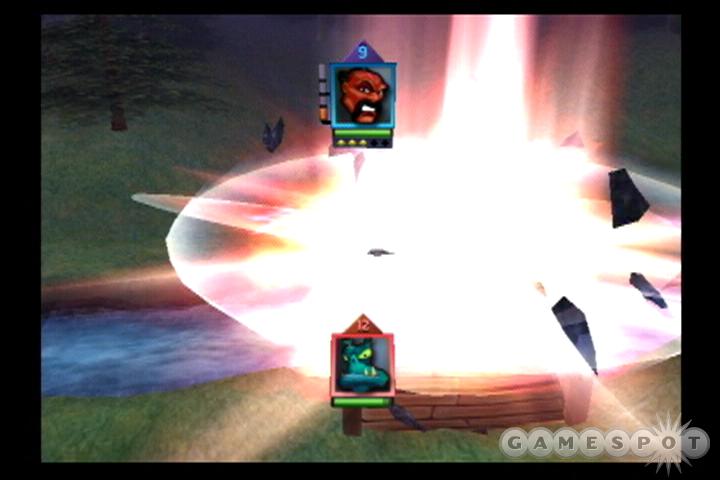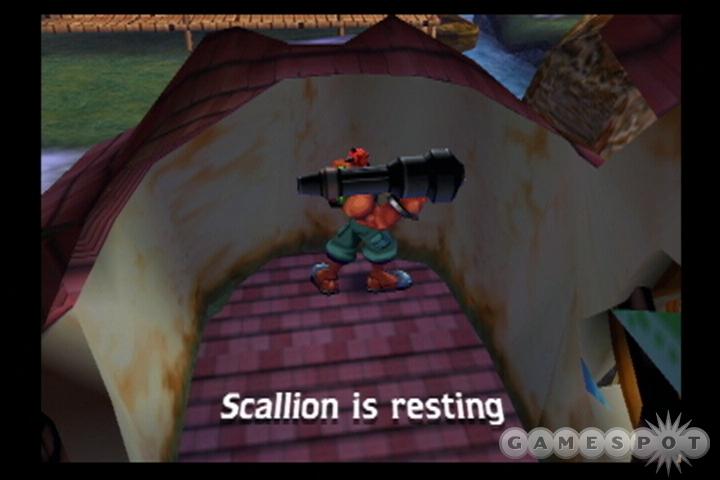Future Tactics: The Uprising is a genre-bending title that takes both turn-based strategy and action-oriented gameplay elements, combines them with RPG-style character advancement, and then throws everything into a world with highly destructible and deformable environments. It's an intriguing experiment that ultimately suffers from shallow, simplistic gameplay and an uninvolving story mode rife with bland characters.

The game is set in a not-too-distant future in which the Earth has become overrun with scores of green aliens known as Creatures. The Creatures appeared on the planet under mysterious circumstances and possessed special regenerative powers that made waging war against them a dangerous and largely futile proposition. After a young man named Low lost his father to a Creature attack, he eventually comes to discover the secret of the aliens' power--a machine called the Immortality Engine that will bring any entity that touches it "back to life" if it dies. Armed with this machine, Low and his friends set out on a trek to destroy the Creatures and free humanity from terror.
The battles in Future Tactics: The Uprising are of a sort of turn-based action that controls equally well on all systems. You start with options to either move or to shoot, and different characters will learn their own special abilities as you upgrade them. Your character has a range of motion in an area delineated by a glowing green circle; the range itself is dependant on both the level of the character and the environment you happen to be in. You can move freely in that predetermined area by both running around and jumping on top of all types of objects, including enemies. Once you stop to use an action, your character will be surrounded by a usually smaller, blue circle that denotes where you can move to once the action is completed. It's a good idea to watch out for this second circle to make sure that you still have the opportunity to duck behind a piece of cover after your turn is finished so that your character isn't exposed to attack.
You fight by selecting the weapon you wish to use--some characters have multiple weapon types--and then finding a Creature to attack. Blaster-type weapons are line of sight, and selecting them brings up a targeting reticule that you manually guide to your chosen foe. Once you've got the initial lock, you'll pinpoint the shot by halting the sweep of two rays and then firing at the intersecting point. Your accuracy depends on how close that point is to the center of your original reticule. Ballistic weapons target via an overhead sonar sweep and are a good area-effect weapon. The crazy thing about the weapons is that all of your arms, great and small, inflict lots of damage on the surrounding areas when they hit. A simple blaster shot will often sink a crater into the ground, cut through part of a rock or hill, send a boulder flying, or smash a building. Purposefully deforming your surroundings often gives you an advantage--you can hide from enemy sight in a deep crater, or send a boulder rolling over a foe. In addition, sometimes there are upgrade items hidden in certain objects in a level that will allow you to upgrade your weapon to increase range, attack more than once, zoom in on your foes, and more. At the end of your turn, you can choose to rest, to try to heal yourself (you will take major damage if hit while healing), or to shield yourself (you will take less damage while shielded, but shields take two turns to recharge).
This all sounds great, and wrecking your surroundings in battle is a worthwhile pastime, but the layers of strategy you employ here are not very deep. You're often either in a situation where you're on a narrow map where it's essentially impossible to avoid the gaze of enemy Creatures, and so you have to use brute force to move along; or you're in a wide map with high (sometimes unassailable) places that you can use to avoid what is often poor enemy artificial intelligence. In the maps where you have to use brute force, you'll often have to play the level over a few times, keeping your experience and leveling your character until you can survive the damage you take. Hiding in your own craters only works if you make them very deep and even then, sometimes a Creature will still be able to find you. Rolling boulders is an inexact science that leaves you often unable to predict where they will fall. While its basic mechanics are interesting, the lack of depth or any real challenge makes the experience suffer. Your motivation to proceed can hardly be supplied by the game's story, either, as it's carried through short cutscenes by characters that are one-dimensional, fulfilling roles instead of appearing as distinct, complex individuals.
Visually, the game utilizes a cartoony style for its characters, with bold, simple lines and strong colors. The aliens have more detail and a greater range of expression than their human counterparts, unfortunately, who can be rather wooden. The environments are at their most interesting when peppered with buildings whose walls crumble and smoke and whose glass shatters when they are stuck by weapon fire. Uninhabited outdoor environments tend to be bland, with simple rocks and vegetation and little to catch the eye. The game's graphics are essentially unchanged over all three systems that it appears on; it does not take advantage of any one platform.
The characters are all fully voiced, and the voice work is actually surprisingly good and solid, if sometimes uninspired. It's a shame that the cast wasn't more fully fleshed out in the actual scripts to better utilize the voice talent. There's a small variety of music in the game that is not especially memorable, but thankfully it's not grating even though it loops often.

Future Tactics: The Uprising supports a multiplayer mode, and battle options and maps for this mode are unlocked by going through the story mode and accomplishing certain objectives. An unlock-status feature can give you clues on actions you must take to unlock certain things, if you wish to spend the time searching for them.
Future Tactics: The Uprising is too simple to be truly satisfying to either fans of the tactical or action genres. The deformable environments can be very neat, but there's only so many times you can watch a hole sink into the ground or shatter a small structure into pieces--there's not much else to the game to really involve you. The title is nice at a budget price, but most people will be better off saving those pennies for a game with more to offer.